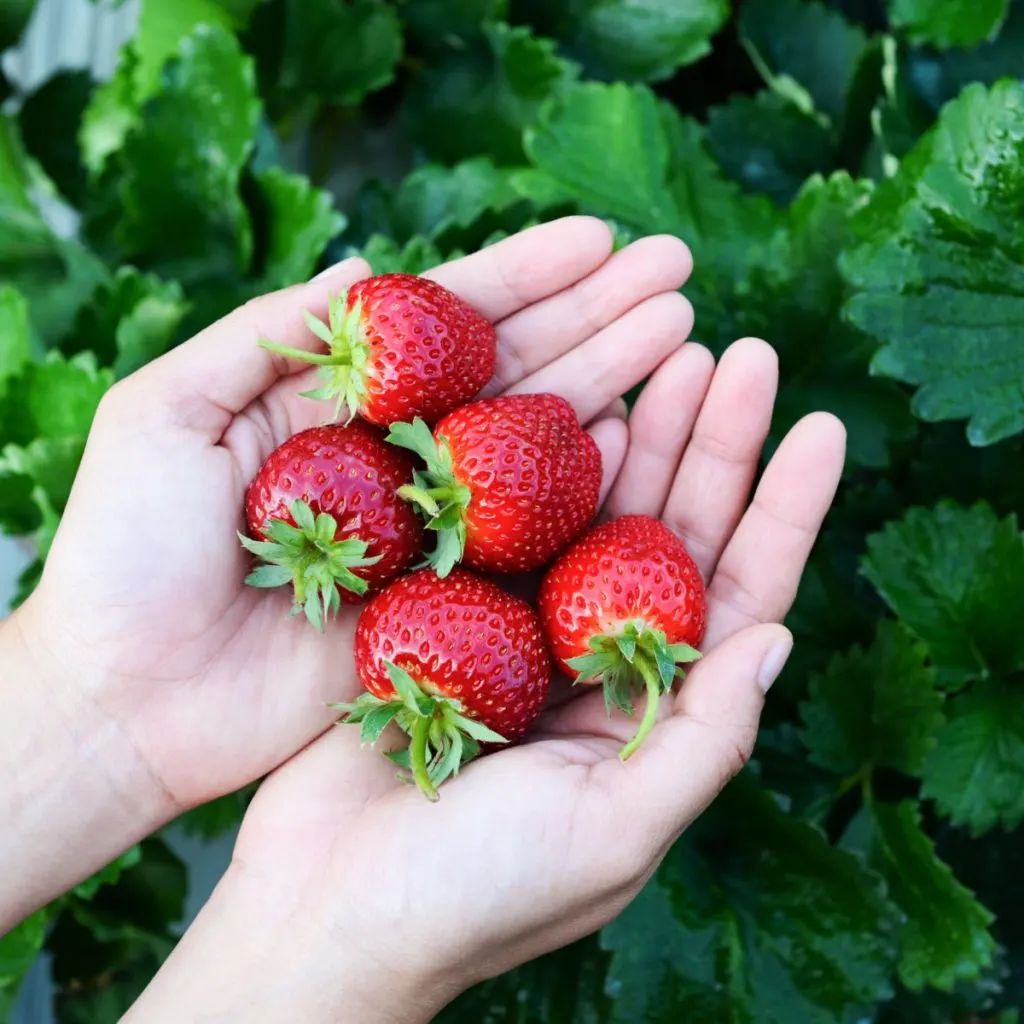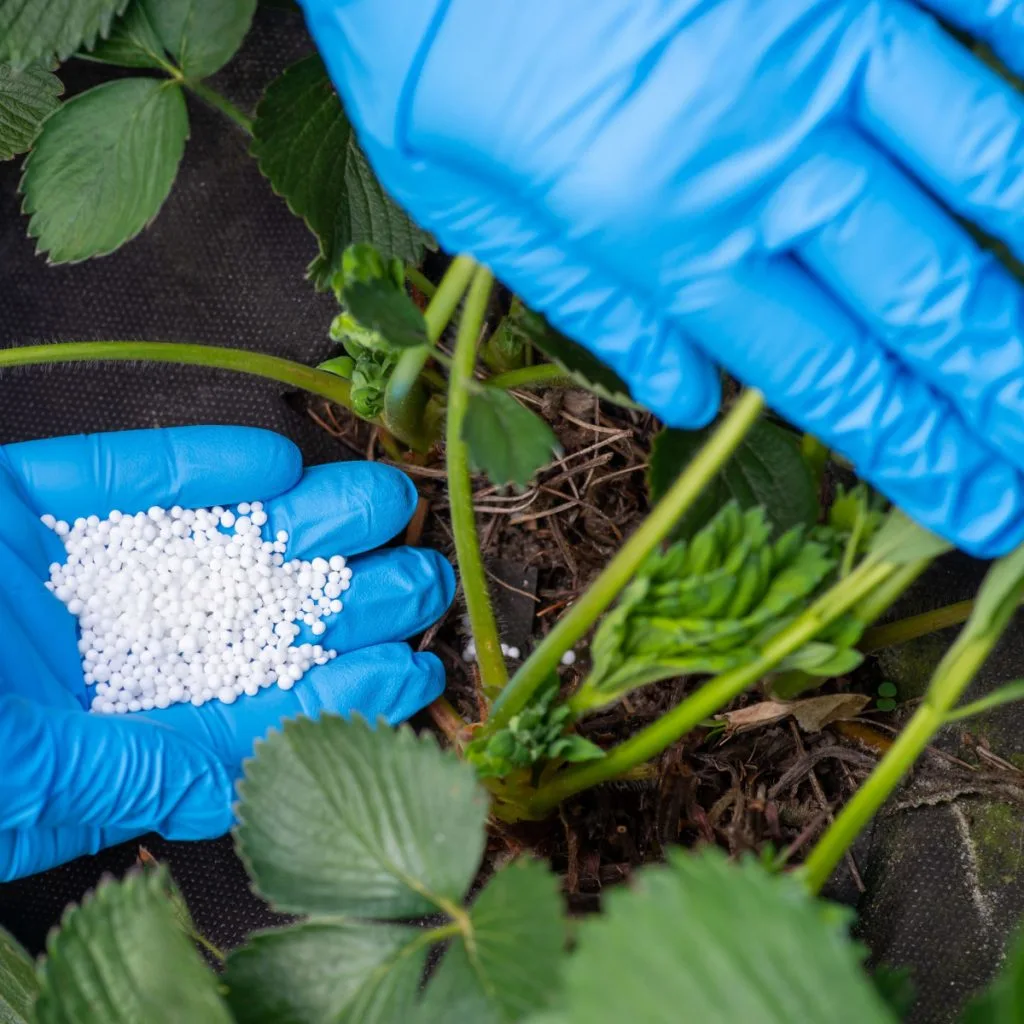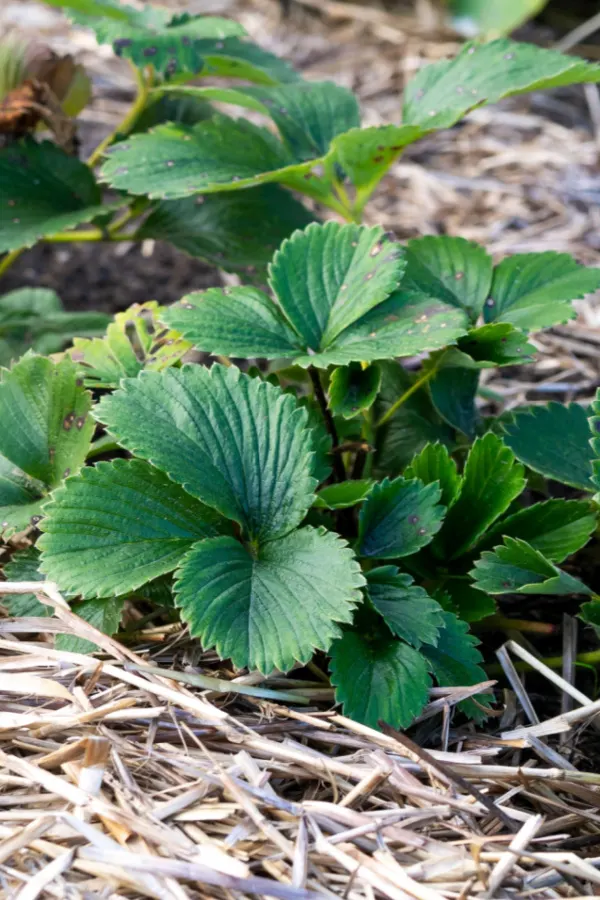When it comes to fertilizing your strawberry plants for a bigger and juicier crop of berries this year – the secret to success all starts with knowing the perfect time to power your plants!
Whether you have perennial everbearing or June bearing strawberries, the soil your berries grow in will eventually lose its power. Like most vegetable and fruit bearing plants, strawberries require a good amount of Nitrogen (N), Phosphorous (P) and Potassium (K) to produce healthy foliage and blooms. And those nutrients can become scarce, even after just a single year of growth.
Unfortunately, unlike annual vegetable plants and flowers, you can’t rotate berry plants to a new space each season. Because of that, with each passing year, without help, the soil will become far less fertile – and of course, your plants far less productive.

The easiest and best way to fix this issue is with fertilizer. But when it comes to strawberry plants, when and how you apply that fertilizer can make a huge difference for your plants. Not just in their ability to produce more berries, but to be able to survive and overwinter with each passing year.
The Secret To Fertilizing Strawberry Plants
When To Fertilize
There are two critical times that strawberry plants need power – and believe it or not – neither of them are when the plants are flowering or starting to produce berries. Actually, as it turns out, that is one of the worst times for giving power to your strawberry plants!
So when should you fertilize? The first application should be early in the growing season before they ever begin to produce foliage or their berries. The second is in mid summer to early fall, before they begin to go dormant for the winter.
The Power Of Early Spring Fertilizing
When it comes to early season fertilizing, you need to supply a dose of power to plants just before or right as they are coming out of their dormant stage. In early spring, plants are ready to begin storing power in their root systems for fruit production. And fertilizing at this point fills that need.

However, if you fertilize once the foliage has come out in full force, the nutrients instead will go more towards leaf growth than production. The end result will be big plants – but ones with little fruit!
As for fertilizing later when strawberry plants start to bloom or as they fruit – you should avoid it entirely. It might seem like a good idea to give plants nutrients as they produce, but the energy can actually cause the plants to stop bloom production to concentrate solely on foliage growth.
If you are planting new strawberry plants in the spring, it’s also best not to fertilize them with traditional fertilizers. Instead, use compost in the planting hole in place of fertilizer. The compost will help roots feed slowly and spread easily. Unfortunately, giving young plants too much power early on can again cause plants to simply produce large foliage.
The Right Choice For Fertilizing Strawberry Plants In The Spring
So what is the best choice of fertilizer for early fertilizing? In early spring, a slow-release granular fertilizer is the way to go. With little foliage growing early in the season, a granular application will slowly soak to the roots below.

Look for fertilizers that are near the 10-10-10 range when it comes to N-P-K. If you can, try to find a mix that actually has a bit higher number for the Potassium (K). Potassium aids greatly in fruit production and is excellent for helping to grow more plentiful and larger berries. Product Affiliate Link: Performance Organics Edibles Plant Nutrition Granules
One thing you want to avoid is any fertilizer that is too heavy on the Nitrogen number. An excess of nitrogen will lead to more leaf growth and less fruit production.
More than anything else, be sure to fertilize early. Apply the fertilizer using the recommended rate on the back of your package. It’s best after you fertilize to water it in a bit. This will help to activate it quickly and allow it to better absorb into the soil.
Powering Plants After Fruiting
Beyond the initial early spring fertilizing time period, it’s also extremely important to power strawberry plants once again in mid summer. This application needs to take place after your plants have completed their fruiting cycle.
For June bearing plants, fertilize in the summer after they have been pruned back. This will help them to regrow and recharge their root systems as well. Not only are strong roots important for good production, but healthy root structures are far less likely to freeze or die out through harsh winters.

This is also the time to plant new runners and transplant any plants. For more on this, see our article: What To Do With Strawberry Plants In The Summer – After Your Harvest Is Over!
If you are growing everbearing varieties of strawberries, it is best to apply a fertilizer in early fall as the plant starts to cease production. This will help it begin to store energy as well for the following year’s fruit.
No matter which type you grow, you can again use a good all purpose granular fertilizer or a few inches of compost to power your plants late in the season. One thing you don’t want to do is fertilize too late into fall. Fertilizing late can actually spur tender late growth, which leaves plants susceptible to winter damage.
Mulching – How To Fertilize Strawberry Plants
Once your strawberry crop begins to die back in late fall, it’s time to put them to bed properly before winter. For this, mulching plants for both weed and winter protection is a must.
Straw or shredded leaves are both excellent materials for this task. A three to four inch coating is more than enough to help plants take on winter. This will help to insulate the soil and keep it from thawing or freezing too quickly. For more fall strawberry care tips, be sure to check out: What To Do With Strawberry Plants In The Fall – Before Winter Arrives!
Here is to fertilizing your strawberry plants at just the right time this year – and with just the right fertilizer. And even more – to a big, bountiful harvest!
This Is My Garden
Follow Our Facebook Page For Great Gardening Tips And Advice! This Is My Garden Facebook Page
This Is My Garden is a garden website created by gardeners, for gardeners. Jim and Mary Competti have been writing gardening, DIY and recipe articles and books and speaking for over 15 years from their 46 acre Ohio farm. They publish three articles every week, 52 weeks a year. Sign up today to follow via email, or follow along!
